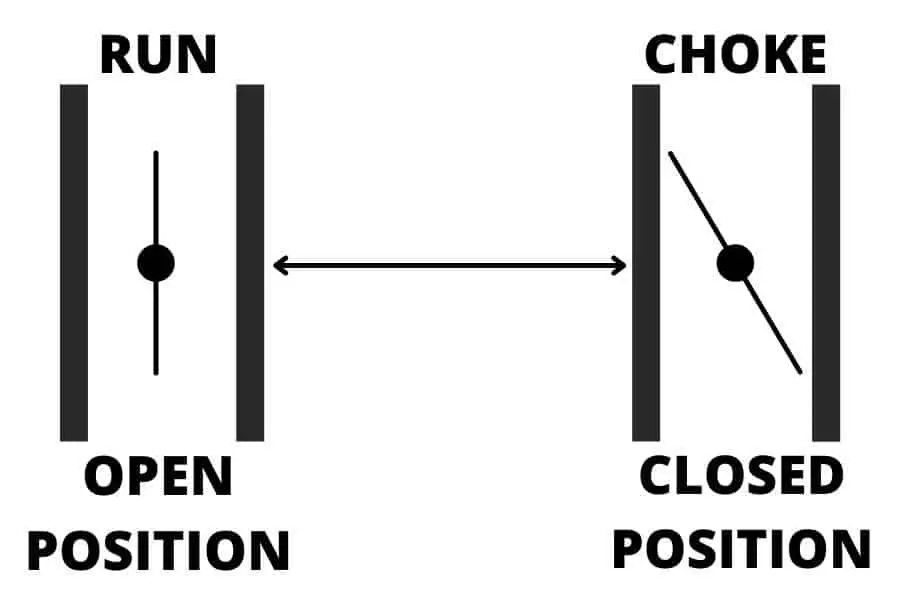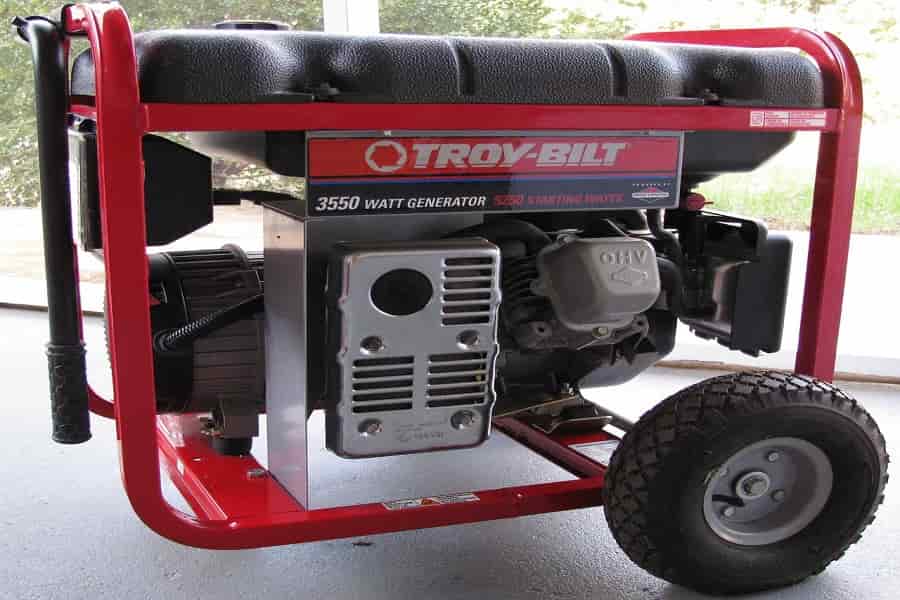Generators have always been the first choice for portable backup power, especially in power outages or long weekend outdoor camping activities. You must put the choke in the (closed position) to start your generator. After starting the generator, you must quickly put it in the (run position). Almost all generators will not indicate which option is the closed or open position with letters. All you will see is run and choke with the two symbols that only a mechanic or someone who daily works on this type of engine will understand. If you are not familiar with the run and choke position symbols, look at the picture (below).

The next time you try to run your generator, you will know which option means choke or run. For some people trying to start the generator can sometimes be challenging, especially if you don’t use these useful machines daily. Next, I want to raise some crucial questions about generators, such as Can you run a generator with the choke on? Why does the generator only run on choke? Is ethanol fuel good for a generator? And also some other essential factors to keep in mind. (Below), let’s go through these essential questions about generators and some helpful tips.
Related Are electric patio heaters any good?
For more on electric patio heaters read the full article.
Can You Run a Generator With The Choke On?
Generally, a generator will run with the choke on, but running it with the choke on all the time may cause some internal damage in the future, such as carburetor failure due to fuel restriction. Therefore, you should put the choke handle in the run position every time you start the generator so that the engine can get the correct amount of gas to run correctly.
Related Do flashlights drain batteries when off? (Mistakes to avoid)
For more on flashlights and batteries read the full article.
Why Does The Generator Only Run on Choke?
If your generator shuts off after starting and only runs on choke, it means there is a gas restriction somewhere in the fuel system. There are many reasons why the fuel system is blocked. Still, the most common is a dirty or faulty carburetor. Even if your generator is new with only a few hours of use, you will need to disassemble the carburetor and inspect it.
See if any internal parts need a replacement; if not, keep cleaning the carburetor with carburetor cleaner to remove any blockages. When this happens, the engine is probably getting all the air needed. Still, the machine will not get the right amount of gas. Here are some steps to consider to make sure you check all possible causes as follows:
1. Inspect for sufficient gas flow.
Ensure that sufficient gas flow is coming from the tank through the fuel system.
2. Look for a vacuum leak.
Ensure that there is no vacuum leak between the carburetor and the engine. Carefully spray the gasket areas with carburetor cleaner while the engine runs if possible. You will hear a change in the engine RPM when you spray in the gaskets between the carburetor and the engine.
3. Inspect the carburetor needle/seat.
If the first step is a yes answer, no fuel is going to the carburetor. Pull the carburetor and pay close attention to the needle/seat opening and closing for more or less fuel.
4. Inspect the float.
If the third step is good, check that fuel fills the bowl through the float. It is rare for the float to come out of adjustment independently, but the float may be stuck at its connection point. Corrosion can also seize it not to go down and allow fuel to enter.
5. Inspect the main jet.
If the float is working correctly, check the main jet, which receives fuel from the tank’s bottom. Ensure there is no junk at the bottom of the fuel bowl and the fuel passage through the metering jest is clear. And that’s all there is to check. The biggest problem is junk in the fuel tank and the metering jet orifice.
Related How to test a car battery at home (With 4 examples)
For more on testing a car battery at home read the full article.
Is Ethanol Fuel Good for a Generator?
Never add gasoline with ethanol to your generator or any small engine. Now, if you don’t use your generator more than every thirty days, you have two options. Either drain the gas and run the engine until the carburetor dries the fuel. The second option is to buy premium gasoline without ethanol and have no more gas decomposition caused by ethanol added to the fuel.
For more on fireplaces read the full article.
How to Use a Generator (Helpful guide)
Power outages are common after a severe storm; however, as I mentioned earlier, a generator can help keep your family comfortable until power is restored. It is best to choose a generator well before the storm hits and familiarize yourself with its operation. There are various options and guidelines for selecting the best one. Finding the right size generator will take some planning.
Before placing the generator, make a list of the items you want to keep running, such as the refrigerator, lights, and other critical mechanical items. You can also consult the manuals or the nameplate of each appliance to determine the power rating or the amount needed to operate the device. For larger appliances, such as a refrigerator, you will also need to know the surge power or required amount to start the appliances.
Add the higher power and add up the energy needed by the generator. Never overload the generator; not only is it unsafe, but it can cause permanent or costly damage to the items it supplies power to. Carefully read and acknowledge the instructions provided by the generator manufacturer. It is also important to note that you will need to use the proper heavy-duty outdoor extension cords. Run the extension cords through a window or door to the unit installed outdoors.
Never install a generator in a garage. A gas generator generates carbon monoxide, so a good rule of thumb is to keep it 20 feet away from the house on a flat, stable surface. Also, don’t plug a generator into an electrical outlet, as the backdraft can create a hazard for utility crews working to restore power.
Before you begin, check for any gas leaks in your home, as severe storms can cause leaks, and if you smell gas, call your local utility company. Suppose you are looking to run a hard-wired appliance, such as a furnace. In that case, an electrician will be necessary to install a power transfer system.
For more on hurricane windows read the full article.
How to Start a Generator
Starting most generators is reasonably straightforward, but always read the instruction manual before first use. Ensure all cables are unplugged and the gas tank is full before starting the generator. The generator should be outdoors, on a flat surface, and safely away from your home. Ensure you have fresh fuel and that the generator is always cool before refueling. Also, when dealing with fuel, store it away from the generator. To start your generator, follow these simple 11 steps:
- Step 1 Make sure the generator is outdoors on a flat surface.
- Step 2 Turn the gas valve to the on position and place the on/off switch in the on position.
- Step 3 Pull the choke lever to the choke position.
- Step 4 Start your generator manually. If your generator has an electric start, then push and hold the start switch in the start position until the generator starts.
- Step 5 After the generator starts, gradually push the choke lever to the run position.
- Step 6 Let the generator run for a while before plugging things in.
- Step 7 Once you are ready to plug things in, start with the item that draws the most power and let it run for a while.
- Step 8 Continue adding other items by alternating circuits.
- Step 9 When it is time to refuel, turn everything off, let the generator run a little longer, turn the generator off, lift the fuel switch, and unplug the extension cords.
- Step 10 Let the generator cool down and only then add more fuel.
- Step 11 Restart the generator as instructed above.
Remember that fresh fuel, as well as oil and spark plugs, are essential to keep the generator running correctly and ready when you need it most.

